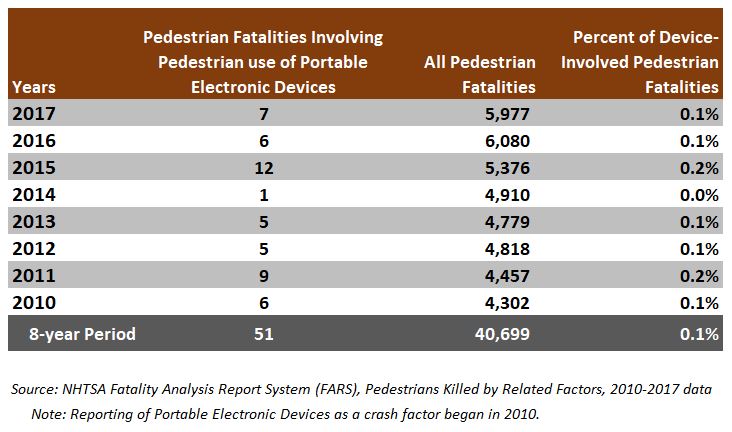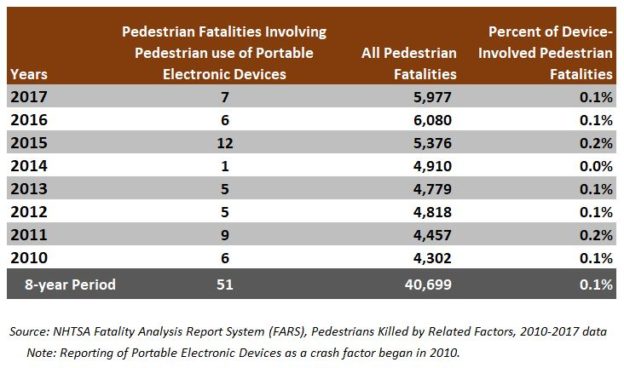by Don Kostelec
September 4, 2019
New York City DOT made news last week with a report titled Distraction Shouldn’t be Deadly. Their bold statement was “DOT found little concrete evidence that device-induced distracted walking contributes significantly to pedestrian fatalities and injuries.”
What stood out most in this report was the data they provided from the National Highway Traffic Safety Administration (NHTSA) and their Fatality Analysis Reporting System (FARS). FARS is the national go-to database for data on traffic fatalities despite having some limitations. Nearly every agency uses it to report on safety-related data. You can sort FARS data many different ways among different transportation modes.
The NYCDOT table shows “pedestrian fatalities involving pedestrian use of portable electronic devices” as a function of all pedestrian fatalities. The report cites NHTSA FARS data indicating that 1/10th of 1 percent of pedestrian deaths were due to distraction on the part of the pedestrian using an electronic device. That’s one out of every 1,000.
I’ve seen this data cited in other places, but had not seen it linked to a source. Until now.
The data is housed in the NHTSA FARS Encyclopedia on Pedestrians: https://www-fars.nhtsa.dot.gov/People/PeoplePedestrians.aspx
My first thought on seeing the NYCDOT table was I wish we had something more current than 2015. Theirs shows 2010 through 2015.
While I’m not ever the first one to leap into the pedestrian blame game, the reason I wanted more recent data is to guard against someone saying “Well, there are a lot more people using smart phones today than in 2015!”
The FARS Encyclopedia delivered. Below is the data for pedestrian use of electronic devices being the related factor in their death. Data for 2017 shows 7 out of 5,977 fatalities–0.1% again. It appears 2010 was the first year that electronic device usage was coded in FARS.

Let’s put that FARS data in context for individual states.
Where I live in Idaho we averaged 14.2 pedestrian deaths per year over the past five years according to the Idaho Transportation Department. If Idaho’s data was consistent with national data, that would mean Idaho would have a device-distracted pedestrian death once every…
Wait for it…
Wait for it…
…56 years!
The other state I frequently track is Utah. Utah averaged 37.2 pedestrian fatalities a year over the past five years according to Utah DOT.
That would mean a device-distracted pedestrian death once every 21.5 years in the Beehive State.
Those are big, rural states, you say. Okay. I’ll give you that.
Let’s go to North Carolina. According to NCDOT’s data, the state averaged 187 pedestrian deaths a year the past five years.
That would equate to a distracted pedestrian death once every 4.3 years in the Good Roads State.
Given that data, answer me this: What state highway safety office would spend time and energy trying to address something that happens only once every 56 years or once every 4.3 years?
None.
Yet, the myth of the distracted pedestrian fits the narrative that we see all-too-often. News stories, agency publications, and safety campaigns all finger wag at the distracted pedestrian. It’s blatant windshield bias.
You never see them cite the data when they talk about it. Now we know why. The data doesn’t support the narrative.
Organizations like the Governors Highway Safety Association (GHSA) are to blame for feeding the frenzy. GHSA’s 2018 report Pedestrian Traffic Fatalities by State was picked up by several news outlets when it was released and is still used in many stories, such as this recent one from the Raleigh News-Observer.
The story from August 27, 2019 had a quote from GHSA’s Director Jonathan Adkins followed by the leap to the distracted pedestrian myth. (I suspect Adkins or their communications people directed the News-Observer reporter to their 2018 report).
- “The Governors Highway Safety Association report cited several possible factors, including the increasing distractions caused by use of cellphones, by both pedestrians and drivers.”
GHSA says on page 34 of that report: “Without stating a direct correlation or claiming a definitive link, more recent factors contributing to the increase in pedestrian fatalities might include…the increasing use of smart phones (which can be a significant source of distraction for both drivers and pedestrians).”
At least GHSA prefaces the statement by saying they don’t have direct correlation or a definitive link. But that didn’t stop them from making the leap in the report–twice! The media now latches onto because it fits the narrative of the distracted pedestrian.
I’d give GHSA more credit if they didn’t use FARS data almost everywhere else in the report.
- Table 1: Pedestrian Fatalities and Percent of Total Traffic Fatalities, 2007-2016 – Source: FARS
- Figure 3: Pedestrian Fatalities by Roadway Type, 2016 – Source: FARS
- Figure 4: 2016 Pedestrian Fatalities by Light Level – Source: FARS
There are many more references to FARS in the report.
If FARS data was good enough for nearly every table and figure GHSA publishes on pedestrian safety, then why wasn’t it good enough to make a table on electronic device usage by dead pedestrians?
I think you know the answer.

